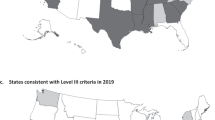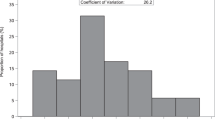Abstract
Objective:
The purpose of this study was to describe variation among states in designations of hospital neonatal services levels.
Study Design:
We systematically searched all 50 states and District of Columbia governmental web sites and extracted definitions and levels terminology, functional and utilization criteria, regulatory compliance and funding measures, and citation of American Academy of Pediatrics (AAP) documents on levels of neonatal care.
Result:
Thirty-three states designate multiple graduated levels of neonatal services. Two to six levels were designated by numbers, titles, or both. Regulatory sources include hospital licensure, Certificate of Need or State Health Plan (CON/SHP), State Health Department, or an affiliated non-governmental entity (SHD/affiliate). Twenty-four states have a single source and nine have two or more. Functional criteria include population characteristics, respiratory care capabilities, and neonatal and cardiac surgery in 25 states. Utilization criteria include capacity, volume, occupancy, or case mix. Compliance mechanisms include license renewal, CON/SHP approval, and/or SHD/affiliate certification. Thirteen states link funding for the highest level of care through Medicaid, Maternal Child Health Title V funds or regional programs. AAP documents are cited or incorporated by reference in 22 states.
Conclusion:
All states regulate health care services and facilities. Definitions, criteria, compliance mechanisms, and regulatory source and status of neonatal levels of service vary widely. A consistent national approach would facilitate comparisons in neonatal outcomes and resource use and be informative to parents, providers, and policy makers. AAP documents could serve as a mechanism to foster such consistency.
This is a preview of subscription content, access via your institution
Access options
Subscribe to this journal
Receive 12 print issues and online access
$259.00 per year
only $21.58 per issue
Buy this article
- Purchase on Springer Link
- Instant access to full article PDF
Prices may be subject to local taxes which are calculated during checkout
Similar content being viewed by others
References
Committee on Perinatal Health. Toward Improving the Outcome of Pregnancy: Recommendations for the Regional Development of Maternal and Perinatal Health Services. The National Foundation—March of Dimes: White Plains, NY, 1976.
Committee on Perinatal Health. Toward Improving the Outcome of Pregnancy: The 90s and Beyond. The National Foundation—March of Dimes: White Plains, NY, 1993.
Brann AE, Cefalo RC (eds). Guidelines for Perinatal Care. Committee on Fetus and Newborn, American Academy of Pediatrics and Committee on Obstetric Practice, American College of Obstetricians and Gynecologists, 1983.
Frigoletto FD, Little GA (eds.) Guidelines for Perinatal Care. 2nd edn, Committee on Fetus and Newborn, American Academy of Pediatrics and Committee on Obstetric Practice, American College of Obstetricians and Gynecologists. 1988.
Freeman RK, Poland RL (eds). Guidelines for Perinatal Care. 3rd edn. Committee on Fetus and Newborn, American Academy of Pediatrics and Committee on Obstetric Practice, American College of Obstetricians and Gynecologists, 1992.
Hauth JC, Merenstein GB (eds). Guidelines for Perinatal Care. 4th edn, Committee on Fetus and Newborn, American Academy of Pediatrics and Committee on Obstetric Practice, American College of Obstetricians and Gynecologists, 1997.
Gilstrap LC, Oh W (eds). Guidelines for Perinatal Care. 5th edn, Committee on Fetus and Newborn, American Academy of Pediatrics and Committee on Obstetric Practice, American College of Obstetricians and Gynecologists, 2002.
Van Marter LJ . Perinatal section surveys and databases. Perinatal Sect News 2000; 26: 8–9.
Blackmon LR, Bhatt DR, Stark AR . Variation of hospital neonatal services definitions and regulatory status. Pediatric Acad Soc 2005; 57: 2198 http://www.abstracts2view.com/pasall/view.php?nu=PAS5L1_1473 (11/08).
Kattwinkel J (ed). Textbook of Neonatal Resuscitation, 5th edn. American Heart Association and American Academy of Pediatrics: Dallas, TX and Elk Grove, IL, 2006.
Committee on Fetus and Newborn. American academy of pediatrics. Levels of neonatal care. Pediatrics 2004; 114: 1341–1347.
Maternal and child health and children with special health care needs five year assessment report. Health systems research, Inc for Idaho Department of Health and Welfare, Division of Health, Bureau of Clinical and Preventive Services. (April 2005) http://www.healthandwelfare.idaho.gov/DesktopModules/DocumentsSortable/DocumentsSrtView.aspx?tabID-0&ItemID=3133&MId=11331&wversion=Staging (November 2008).
Strobino DM, Grason HT, Koontz AM, Silver GB . Reexamining the organization of perinatal services systems, a preliminary report. Women and Child Health Policy Center. Johns Hopkins School of Public Health. Maternal and Child Health Bureau, Health Resources and Services Administration, U.S. Department of Health and Human Services. 2000.
Shaffer ER . State policies and regional neonatal care. The National Foundation—March of Dimes, White Plains, NY, 2001.
Johnson KA, Little GA . State health agencies and quality improvement in perinatal care. Pediatr 1999; 103: 233–247 (Supplement).
Fisher ES, Bynum JP, Skinner JS . Slowing the growth of health care costs—lessons from regional variation. N Engl J Med 2009; 360: 849–852.
Phibbs CS, Baker LC, Caughey AB, Danielsen B, Schmitt SK, Phibbs RH . Level and volume of neonatal intensive care and mortality in very-low-birth-weight infants. N Engl J Med 2007; 356: 2165–2175.
National Performance Measures, Title V Block Grant Program, Maternal and Child Health Bureau, Health Resources and Services Administration, U.S. Department of Health and Human Services. https://perfdata.hrsa.gov/MCHB/TVISReports/MeasurementData/NationalMeasureIndicatorSearch.aspx?Type=Performance&YearType=MultiYear (11/08).
U.S. Department of Health and Human Services. Healthy People 2010, Understanding and Improving Health, 2nd edn. 16, Maternal, Infant, and Child Health, 2000, http://www.healthypeople.gov/Document/HTML/Volume2/16MICH.htm.
Goodman DC, Fisher ES, Little GA, Stukel TA, Chang CH . Are neonatal intensive care resources located according to need? Regional variation in neonatologists, beds, and low birth weight newborns. Pediatrics 2001; 108: 426–431.
Acknowledgements
We acknowledge the valuable contributions of Dilip R Bhatt, MD and his staff to our earlier work in this area that were the basis for the preliminary report at the Pediatric Academic Societies May, 2005 and informed this 2008 update and re-analysis. The findings and conclusions in this report are those of the authors and do not necessarily represent the official position of the Centers for Disease Control and Prevention.
Author information
Authors and Affiliations
Corresponding author
Rights and permissions
About this article
Cite this article
Blackmon, L., Barfield, W. & Stark, A. Hospital neonatal services in the United States: variation in definitions, criteria, and regulatory status, 2008. J Perinatol 29, 788–794 (2009). https://doi.org/10.1038/jp.2009.148
Received:
Revised:
Accepted:
Published:
Issue Date:
DOI: https://doi.org/10.1038/jp.2009.148
Keywords
This article is cited by
-
NICUs in the US: levels of acuity, number of beds, and relationships to population factors
Journal of Perinatology (2023)
-
Seven years later: state neonatal risk-appropriate care policy consistency with the 2012 American Academy of Pediatrics Policy
Journal of Perinatology (2022)
-
CDC LOCATe: discrepancies between self-reported level of maternal care and LOCATe-assessed level of maternal care among 463 birth facilities
Journal of Perinatology (2022)
-
Trends in neonatal intensive care unit admissions by race/ethnicity in the United States, 2008–2018
Scientific Reports (2021)
-
Designation of neonatal levels of care: a review of state regulatory and monitoring policies
Journal of Perinatology (2020)



